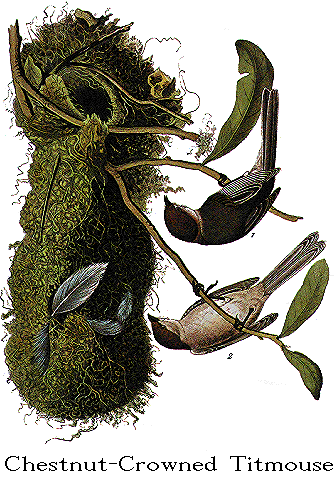Birds of America
By John James Audubon, F. R. SS. L. & E.
VOLUME II.



Family
Genus

CHESTNUT-CROWNED TITMOUSE.
[Bushtit.]
PARUS MINIMUS, Towns.
[Psaltriparus minimus.]

PLATE CXXX.--MALE AND FEMALE.
My friend NUTTALL'S account of this Titmouse is as follows.--"We first
observed the arrival of this plain and diminutive species on the banks of the
Wahlamet, near to its confluence with the Columbia, about the middle of May.
Hopping about in the hazel thickets which border the alluvial meadows of the
river, they appeared very intent and industriously engaged in quest of small
insects, chirping now and then a slender call of recognition. They generally
flew off in pairs, but were by no means shy, and kept always in the low bushes
or the skirt of the woods. The following day I heard the males utter a sort of
weak monotonous short and quaint song, and about a week afterwards I had the
good fortune to find the nest, about which the male was so particularly
solicitous as almost unerringly to draw me to the spot, where hung from a low
bush, about four feet from the ground, his little curious mansion, formed like a
long purse, with a round hole for entrance near the summit. It was made chiefly
of moss, down, lint of plants, and lined with some feathers. The eggs, six in
number, were pure white, and already far gone towards being hatched. I saw but
few other pairs in this vicinity, but on the 21st of June, in the dark woods
near Fort Vancouver, I again saw a flock of about twelve, which, on making a
chirp something like their own call, came around me very familiarly, and kept up
a most incessant and querulous chirping. The following season (April 1836) I
saw numbers of these birds in the mountain thickets around Santa Barbara, in
Upper California, where they again seemed untiringly employed in gleaning food
in the low bushes, picking up or catching their prey in all postures, sometimes
like the common Chickadee, head downwards, and letting no cranny or corner
escape their unwearied search. As we did not see them in the winter, they
migrate in all probability throughout Mexico and the Californian peninsula at
this season."
According to Mr. TOWNSEND, "the Chinooks name it a-ha-ke-lok. It is a
constant resident about the Columbia river; hops about in the bushes, and
frequently hangs from the twigs in the manner of other Titmice, twittering all
the while with a rapid enunciation resembling the words thshish, tshist, tsee,
twee. The irides are bright yellow."
PARUS MINIMUS, Chestnut-crowned Titmouse, Towns. Jour. Acad. Nat. Sc.
Philadelphia, vol. vii. p. 190.
CHESTNUT-CROWNED TITMOUSE, Parus minimus, Aud. Orn. Biog., vol. iv. p. 382.
Adult Male.
Bill short, strong, compressed; upper mandible with its outline arched, the
sides sloping and convex; the edges sharp, the tip descending, acute, and
considerably exceeding that of the lower; which has the angle short, the dorsal
line ascending and very slightly convex, the edges sharp, the tip acute.
Nostrils round, basal. Head rather large, broadly ovate, convex in front; neck
short; body slender. Feet of moderate length, tarsus proportionally longer than
in any other American species, stout, compressed, with seven anterior scutella,
and two lateral plates, forming a very sharp edge behind. Toes moderately
stout, the first with its claw equal to the third, the anterior united as far as
the first web. Claws rather large, arched, compressed, acute.
Plumage soft and blended. Wings short, very broad, concave, rounded; first
quill half the length of the second, which is a quarter of all inch shorter than
the outer secondaries. Tail very long, being half the entire length of the
bird, slightly arched, much rounded, and a little emarginate.
Bill black; feet and claws dusky or blackish-brown. Upper part of the bead
and hind neck dull greyish-brown; upper parts brownish-grey; wings and tail
dusky brown, tinged with grey, the margins of the quills and tail-feathers
greyish-white. Cheeks of a paler tint than the head; all the lower parts
brownish-white, the sides tinged with reddish.
Length to end of tail 4 1/2 inches; wing from flexure 1 (10 1/2)/12; tail
2 2/12; bill along the ridge (4 1/4)/12; tarsus 7/12; hind toe (2 3/4)/12,
its claw (2 3/4)/12; middle toe 4/12, its claw 2/12.
Adult Female.
The female is rather smaller, and its colours are somewhat paler.
A nest presented to me by Mr. NUTTALL is of a cylindrical form, nine inches
long and three and a half in diameter. It is suspended from the fork of a small
twig, and is composed externally of hypna, lichens, and fibrous roots,
interwoven so as to present a smoothish surface, and with a few stems of
grasses, and some feathers of Garrulus Stelleri intermixed. The aperture, which
is at the top, does not exceed seven-eighths of an inch in diameter; but for
two-thirds of the length of the nest, the internal diameter is two inches. This
part is lined with the cottony down of willows, carefully thrust into the
interstices, and contains a vast quantity of soft feathers, chiefly of Steller's
Jay, with some others, among which can be distinguished those of Tetrao
urophasianus, Columba fasciata, and Tanagra ludoviciana. The eggs, nine in
number, are pure white, (4 1/2)/8 of an inch in length, by (3 1/2)/8 broad, and
are rather pointed at the small end.









